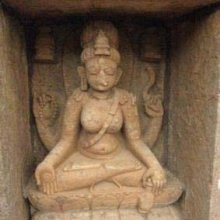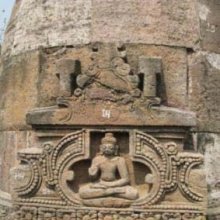Bhrukuti, Bhrukuṭī, Bhrukuṭi, Bhrūkuṭi, Bhru-kuti, Bhrūkuṭī: 19 definitions
Introduction:
Bhrukuti means something in Hinduism, Sanskrit, Marathi. If you want to know the exact meaning, history, etymology or English translation of this term then check out the descriptions on this page. Add your comment or reference to a book if you want to contribute to this summary article.
Images (photo gallery)
In Hinduism
Purana and Itihasa (epic history)
Source: Wisdom Library: The Matsya-purāṇaBhrukuṭī (भ्रुकुटी) is the name of a mind-born ‘divine mother’ (mātṛ), created for the purpose of drinking the blood of the Andhaka demons, according to the Matsya-purāṇa 179.8. The Andhaka demons spawned out of every drop of blood spilled from the original Andhakāsura (Andhaka-demon). According to the Matsya-purāṇa 179.35, “Most terrible they (e.g., Bhrukuṭī) all drank the blood of those Andhakas and become exceedingly satiated.”
The Matsyapurāṇa is categorised as a Mahāpurāṇa, and was originally composed of 20,000 metrical verses, dating from the 1st-millennium BCE. The narrator is Matsya, one of the ten major avatars of Viṣṇu.
Source: archive.org: Shiva Purana - English TranslationBhrukuṭī (भ्रुकुटी) refers to the “two eyebrows” (of Pārvatī), according to the Śivapurāṇa 2.3.18 (“Description of the perturbation caused by Kāma”).—Accordingly, as Śiva described Pārvatī: “Is this your face or the moon? Are these your eyes or lotus petals? These two eyebrows [i.e., bhrukuṭī] are the bows of Kāma of noble soul. Is this your lower lip or Bimba fruit? Is this your nose or the beak of a parrot? Do I hear your voice or the cooing of the cuckoo? Is this your slender waist or the sacrificial altar? How can her gait be described? How can her comely appearance be described? How can the flowers be described? How can the clothes be described? [...]”.
Source: Cologne Digital Sanskrit Dictionaries: The Purana IndexBhrukuṭī (भ्रुकुटी).—A mind-born mother.*
- * Matsya-purāṇa 179. 19.

The Purana (पुराण, purāṇas) refers to Sanskrit literature preserving ancient India’s vast cultural history, including historical legends, religious ceremonies, various arts and sciences. The eighteen mahapuranas total over 400,000 shlokas (metrical couplets) and date to at least several centuries BCE.
Natyashastra (theatrics and dramaturgy)
Source: Wisdom Library: Nāṭya-śāstraBhrukuṭī (भ्रुकुटी, “knitting”) refers to a specific gesture (āṅgika) made with the eyebrows (bhrū), according to the Nāṭyaśāstra chapter 8. These gestures of the eyelids (puṭa) are supposed to be performed in accordance with the corresponding gestures of the eyeballs (tārā) and the eyelids (puṭa). These gestures form a part of the histrionic representation (abhinaya).
Source: archive.org: Natya ShastraBhrukuṭī (भ्रुकुटी, “knitting”).—A type of gesture (āṅgika) made with the eyebrows (bhrū);—Instructions: raising the root of the eyebrows. Uses: in objects of anger (krodha), dazzling (sthāna) light (dīpta).
Source: archive.org: Illustrations of Indian Music and Dance in Western Indian Style (natya)Bhrukuṭī (भ्रुकुटी) refers to “raising the endings of the eye-brows”, and is classified as one of the seven movements of the eye-brows, which forms a part of upāṅga (minor body-parts) in Nāṭyaśāstra. Bhrukuṭī can be used in wrath.

Natyashastra (नाट्यशास्त्र, nāṭyaśāstra) refers to both the ancient Indian tradition (shastra) of performing arts, (natya—theatrics, drama, dance, music), as well as the name of a Sanskrit work dealing with these subjects. It also teaches the rules for composing Dramatic plays (nataka), construction and performance of Theater, and Poetic works (kavya).
Shaivism (Shaiva philosophy)
Source: SOAS University of London: Protective Rites in the Netra TantraBhrukuṭī (भ्रुकुटी) refers to a “frown”, according to the Netratantra of Kṣemarāja: a Śaiva text from the 9th century in which Śiva (Bhairava) teaches Pārvatī topics such as metaphysics, cosmology, and soteriology.—Accordingly, [verse 10.1-7ab, while describing the appearance and worship of Bhairava]—“Now, at this moment, I shall explain the distinct appearance of Bhairava, [who] resembles an ointment [that clears the eye]. He has a nature that burns up and dissolves all things. Five-faced, atop a corpse, ten-armed [and] terrible, he resembles troops with demon mouths. He rumbles, [producing] a terrible noise, speaks with a gaping mouth [adorned with] with large tusks, [his face] bent in a frown (bhrukuṭī-kuṭila-īkṣaṇa). [...] Having worshipped Bhairava, [the Mantrin] remembers being joined in union [with] him, [in the same way as] dissolution in fire”.

Shaiva (शैव, śaiva) or Shaivism (śaivism) represents a tradition of Hinduism worshiping Shiva as the supreme being. Closely related to Shaktism, Shaiva literature includes a range of scriptures, including Tantras, while the root of this tradition may be traced back to the ancient Vedas.
Languages of India and abroad
Marathi-English dictionary
Source: DDSA: The Molesworth Marathi and English Dictionarybhrukuṭī (भ्रुकुटी).—f (S) Contraction of the brows, a frown; but, commonly, the brow or a brow. bhru0 caḍhaviṇēṃ To frown.
Source: DDSA: The Aryabhusan school dictionary, Marathi-Englishbhrukuṭī (भ्रुकुटी).—f Contraction of the brows, a frown. A brow.
Marathi is an Indo-European language having over 70 million native speakers people in (predominantly) Maharashtra India. Marathi, like many other Indo-Aryan languages, evolved from early forms of Prakrit, which itself is a subset of Sanskrit, one of the most ancient languages of the world.
Sanskrit dictionary
Source: DDSA: The practical Sanskrit-English dictionaryBhrukuṭi (भ्रुकुटि) or Bhrukuṭī (भ्रुकुटी).—See भ्रूकुटि (bhrūkuṭi); समर्प्यमाणं सुदृशा नाग्रहीद्भ्रुकुटीमुखः (samarpyamāṇaṃ sudṛśā nāgrahīdbhrukuṭīmukhaḥ) Bm.1.266.
Derivable forms: bhrukuṭiḥ (भ्रुकुटिः).
--- OR ---
Bhrūkuṭi (भ्रूकुटि) or Bhrūkuṭī (भ्रूकुटी).—f. contraction or knitting of the eyebrows, a frown. °बन्धः, °रचना (bandhaḥ, °racanā) bending or knitting the eyebrows; °मुखम् (mukham) a frowning face; भ्रूकुटिं बन्ध् (bhrūkuṭiṃ bandh) or रच् (rac) 'to knit the eyebrows, to frown'.
Derivable forms: bhrūkuṭiḥ (भ्रूकुटिः).
Bhrūkuṭi is a Sanskrit compound consisting of the terms bhrū and kuṭi (कुटि).
Source: Cologne Digital Sanskrit Dictionaries: Shabda-Sagara Sanskrit-English DictionaryBhrukuṭi (भ्रुकुटि).—f. (-ṭiḥ-ṭī) A frown. E. bhru for bhrū an eye-brow, kuṭ to make crooked, in aff.: see bhrūkuṭi .
--- OR ---
Bhrūkuṭi (भ्रूकुटि).—f. (-ṭiḥ-ṭī) A frown, a look of displeasure. E. bhrū the brow, kuṭ to be curved, aff. in and ṅīp optionally added; it is also written variously, like the last, and occures bhrukuṭi, bhṛkuṭi, or bhrakuṭi.
Source: Cologne Digital Sanskrit Dictionaries: Benfey Sanskrit-English DictionaryBhrukuṭi (भ्रुकुटि).—see bhrūkuṭi.
--- OR ---
Bhrūkuṭi (भ्रूकुटि).—[bhrū-kuṭī], or bhrukuṭi, ṭī bhrukuṭī, or bhrakuṭi bhrakuṭi, and bhṛkuṭi, ṭī bhṛkuṭī, f. A frown, Mahābhārata 1, 4601 (bhrū-); 7, 762 (bhru-); [Pañcatantra] 220, 1 (bhṛº).
Bhrūkuṭi can also be spelled as Bhrūkuṭī (भ्रूकुटी).
Source: Cologne Digital Sanskrit Dictionaries: Cappeller Sanskrit-English DictionaryBhrukuṭi (भ्रुकुटि).—[feminine] = bhrukuṭi.
--- OR ---
Bhrukuṭī (भ्रुकुटी).—[feminine] = bhrukuṭi.
Source: Cologne Digital Sanskrit Dictionaries: Monier-Williams Sanskrit-English Dictionary1) Bhrūkuṭī (भ्रूकुटी):—[=bhrū-kuṭī] [from bhrū] f. contraction of the brows, a frown (also -kuṭi, [Pāṇini 6-3, 61], [vArttika] 3, [Patañjali, and] -kuṭika mfn. ifc. [cf. Lexicographers, esp. such as amarasiṃha, halāyudha, hemacandra, etc.]), [Mahābhārata; Rāmāyaṇa] etc.
2) [v.s. ...] [accusative] with √kṛ or bandh, to knit the eyebrows
3) Bhrukuṭi (भ्रुकुटि):—[=bhru-kuṭi] [from bhru > bhrū] f. = bhrū-kuṭi (also ti-bandha, ṭi-racanā etc.), [Mahābhārata; Kāvya literature] etc.
4) [v.s. ...] m. (also) a kind of snake, [Suśruta]
5) Bhrukuṭī (भ्रुकुटी):—[=bhru-kuṭī] [from bhru > bhrū] f. = bhrū-kuṭi (also ti-bandha, ṭi-racanā etc.), [Mahābhārata; Kāvya literature] etc.
Source: Cologne Digital Sanskrit Dictionaries: Yates Sanskrit-English Dictionary1) Bhrukuṭi (भ्रुकुटि):—(ṭiḥ) 2. f. A frown.
2) Bhrūkuṭi (भ्रूकुटि):—[bhrū-kuṭi] (ṭiḥ) 2. f. A frown.
[Sanskrit to German]
Sanskrit, also spelled संस्कृतम् (saṃskṛtam), is an ancient language of India commonly seen as the grandmother of the Indo-European language family (even English!). Closely allied with Prakrit and Pali, Sanskrit is more exhaustive in both grammar and terms and has the most extensive collection of literature in the world, greatly surpassing its sister-languages Greek and Latin.
Kannada-English dictionary
Source: Alar: Kannada-English corpusBhrukuṭi (ಭ್ರುಕುಟಿ):—
1) [noun] frowned brows.
2) [noun] a scowling expression; a frowning look.
3) [noun] (dance.) a quick raising of an eye-brow.
--- OR ---
Bhrūkuṭi (ಭ್ರೂಕುಟಿ):—[noun] = ಭ್ರುಕುಟಿ - [bhrukuti -] 1 & 2.
Kannada is a Dravidian language (as opposed to the Indo-European language family) mainly spoken in the southwestern region of India.
Nepali dictionary
Source: unoes: Nepali-English DictionaryBhrukuṭī (भ्रुकुटी):—n. 1. eyebrow; brow; 2. → चन्द्रमण्डल [candramaṇḍala]
Nepali is the primary language of the Nepalese people counting almost 20 million native speakers. The country of Nepal is situated in the Himalaya mountain range to the north of India.
See also (Relevant definitions)
Starts with: Bhrukutibandha, Bhrukutibhanga, Bhrukutika, Bhrukutikrit, Bhrukutikutika, Bhrukutikutila, Bhrukutikutilanana, Bhrukutimukha, Bhrukutiracana.
Ends with: Baddhabhrukuti, Udamcitabhrukuti, Udbhrukuti, Vikarnabhrukuti.
Full-text (+9): Bhrakuti, Bhrukutimukha, Bhrikuti, Trishakha, Bhrukutikrit, Bhrukutikutila, Bhrukutiracana, Bhrukutikutilanana, Bhrukutibandha, Bhrukutikutika, Bhakuti, Pirukuti, Bhrubhanga, Bhrukutika, Pratilakshana, Samhatabhrukutimukha, Bhrukumsa, Bhukuti, Pukuti, Trishikha.
Relevant text
Search found 10 books and stories containing Bhrukuti, Bhru-kuti, Bhrū-kuṭi, Bhrū-kuṭī, Bhru-kuṭi, Bhru-kuṭī, Bhrukuṭī, Bhrukuṭi, Bhrūkuṭi, Bhrūkuṭī; (plurals include: Bhrukutis, kutis, kuṭis, kuṭīs, Bhrukuṭīs, Bhrukuṭis, Bhrūkuṭis, Bhrūkuṭīs). You can also click to the full overview containing English textual excerpts. Below are direct links for the most relevant articles:
Bhakti-rasamrta-sindhu (by Śrīla Rūpa Gosvāmī)
Verse 2.5.63 < [Part 5 - Permanent Ecstatic Mood (sthāyī-bhāva)]
Verse 2.5.66 < [Part 5 - Permanent Ecstatic Mood (sthāyī-bhāva)]
Verse 3.4.26 < [Part 4 - Parenthood (vātsalya-rasa)]
Gati in Theory and Practice (by Dr. Sujatha Mohan)
Gati used for the delineation of Bhāva and Rasa < [Chapter 3 - Application of gati in Dṛśya-kāvyas]
Satirical works of Kshemendra (study) (by Arpana Devi)
5.13. The Unchaste Widow (raṇḍā) < [Chapter 5 - Kṣemendra’s objectives of Satire]
Chaitanya Bhagavata (by Bhumipati Dāsa)
Verse 2.6.146 < [Chapter 6 - The Lord’s Meeting with Advaita Ācārya]
Verse 2.19.156 < [Chapter 19 - The Lord’s Pastimes in Advaita’s House]
Verse 2.18.35 < [Chapter 18 - Mahāprabhu’s Dancing as a Gopī]
Malatimadhava (study) (by Jintu Moni Dutta)
Part 1.3c - Raudra Rasa (The Furious Sentiment) < [Chapter 2 - Literary Study of the Mālatīmādhava]
Jivanandana of Anandaraya Makhin (Study) (by G. D. Jayalakshmi)
Analysis of Rajayakṣmā (Pratināyaka) < [Chapter 6 - Dramatic aspects of the Jīvanandana Nāṭaka]

